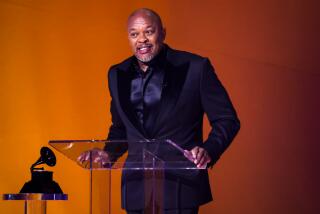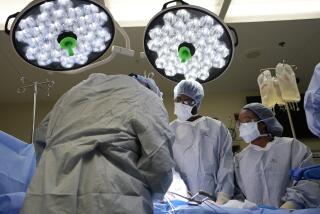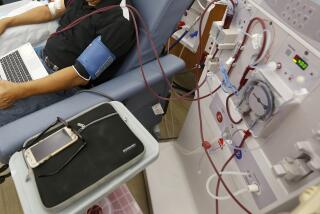A Patient Fight to Help Others : Medicine: An Arcadia man is addressing the pain and trauma of his hard-to-diagnose kidney disease by raising funds for kidney reasearch and a new professorship at USC.
David Thornton visited 26 doctors before physicians at USC Medical Center diagnosed his rare kidney disease. He was told he might have intestinal cancer, blood clots in his lungs or lupus before USC surgeons removed one kidney and operated on the other.
Doctors say patients undergoing that kind of trauma frequently try to forget their disease--or deny it--but Thornton, 24, responded by starting a foundation to raise $2.5 million for kidney research. He wants to endow a research suite and a professorship in a new tower at USC’s Kenneth Norris Jr. Comprehensive Cancer Hospital.
“It’s mainly because of my pain,” Thornton said recently in the Pasadena office he opened in July. “When I went to all those different places for answers, the answers weren’t there. I want to do what I can to make sure other people don’t have to go through what I went through. And it might be a way to find something to keep me alive.
“I have not received a death sentence. I have just been given a new outlook. I want to do what I can to help others today because I don’t know if I’ll be in bed with pain all day tomorrow.”
The Thornton Kidney Research Foundation will hold a free kick-off reception at 4 p.m. Wednesday, in the Norris Comprehensive Cancer Center.
Most of the expected 130 guests will be family and old friends, but USC president Dr. James H. Zumberge and members of the school’s board of directors will also attend.
Thornton, who lives in Arcadia, is confident this group will help him reach his goal. “These men are well-known in the community,” he said. “They will get the information out about what the foundation is doing. The guests are not just my family and friends. It’s also the hierarchy of USC.”
Thornton began working on the foundation in January after sounding out his physicians on his plans. He used his savings and a grant from another foundation for expenses and relied on the USC Comprehensive Cancer Center development office for advice on direct mail, solicitation of major gifts and other matters.
“Lots of people can write a check or make a commitment over five years,” said Bill Watson, director of development for the Comprehensive Cancer Center. “But for someone to put in the time and energy that he has is very unusual.
“There may be some techniques a professional development officer would need to use,” Watson said, “whereas the sincerity David represents is obvious. I’ve seen how people react to him. To be successful is to really understand your product and what you’re asking a donor to give toward, and he’s obviously lived through what he’s representing.”
Dr. Jeffry Huffman, the associate professor of urology at the USC School of Medicine who is Thornton’s physician, said he and other doctors were impressed by Thornton’s plans.
“I knew he had a lot of resources as far as family and as far as knowing a lot of people willing to support a foundation,” Huffman said. “When he had surgery, he had 20 to 30 family members waiting for him after the operation. You could tell there was a lot of support.”
Thornton’s father, Franklin, is a Pasadena architect, and his mother, Patricia, directs a preschool and middle-school in Duarte.
“I think he will succeed,” Huffman said. “Everything I’ve seen is very positive. His resources are his internal drive and his hard work.”
Huffman met Thornton in 1988 when he was a senior speech communication major at Cal State Long Beach. It was a year after his pain had begun and after Thornton had been through a long trail of other doctors.
Huffman examined him with a 3-millimeter endoscope that he had helped develop. He discovered the source of Thornton’s internal bleeding was an abnormal blood vessel and learned that Thornton’s condition, a disease associated with pain and bleeding from the kidneys, was so rare that it “doesn’t fit in the normal category of disease entities.”
“He was the only one who saw the abnormal bleeding from the blood vessel in the kidney,” Thornton said, “and he was well known for his procedures in looking for that condition. I just felt comfortable with him. He was like the quarterback. He took control of the situation and saw the whole picture. Before that I was going to specialists for each area of my body.”
Huffman said Thornton’s disease most closely resembles angio dysplasia or hematuria loin pain syndrome, “but we have been unable to really prove it because he tends to bleed a lot from other organs such as his lungs or gastrointestinal tract.”
Huffman said surgeons first removed part of the left kidney, which was causing most of the bleeding.
“He was virtually normal on the left side for about a year before the pain resumed and it was necessary to remove the rest of that kidney,” the physician said.
“After the first surgery he did well and was off medications and went back to work and school for four to six months,” Huffman said.
Thornton was graduated from college in 1988 and worked as a vice president for an Orange County firm before resigning when he started having pain on the right side.
“So we removed the nerve supply to the right kidney to eliminate the sensation of pain,” Huffman said. “He was healthy for about a year but now he’s starting to have some discomfort on that side.”
Thornton, who spent 70 days in the hospital during a two-year stretch, will soon be readmitted to the Norris Comprehensive Cancer Center so doctors can monitor his reaction to new pain medication. Doctors will watch him carefully because he reacted to medications twice with cardiac arrhythmias and had to be resuscitated.
Huffman said that although medical literature is limited, Thornton’s condition does not appear fatal. “What I’ve told him all along is that I don’t expect this to be a life-threatening problem,” he said. “It is not a cancer. It will not metastasize. He is able to carry out a fairly normal daily routine.
“Certainly it is a major problem. There is a lot of uncertainty and that tends to affect your mind set. There is the possibility that we will have to move his kidney to another spot, put him on dialysis or do a transplant from someone else somewhere down the line. But I tend to be optimistic about his prognosis.”
Certainly Thornton appears healthy. The former lifeguard retains good coloring and, at 6-foot-1 and 165 pounds, looks as if he could still maneuver through hundreds of feet of waves to rescue a swimmer.
“People say, ‘You look well and you look happy,’ ” he said. “I think that’s a great plus. I do not want to come across as a sick person who wants sympathy.”
But appearances are deceiving, Thornton said. Fatigue prevents him from working more than six hours a day, and he winced during a recent interview, recalling the pain that awakened him the previous morning.
“It’s almost like a knife moving inside the organ,” he said.
Thornton is determined that the pain not prevent him from orchestrating a money-raising campaign rarely pursued by someone his age.
In his office, he displays a signed picture of George Bush and a large American flag. His large, efficiently organized wood desk holds only a personal computer and several neatly stacked piles of paper.
Thornton appears all business in neatly trimmed hair, a bold-patterned tie and a crisply pressed summer suit.
“I’m not looking on my condition as fatal,” he said. “If I were looking on it that way, I don’t think I’d be doing this. I think I’d be depressed somewhere. If it were so close, I’d be giving into it. And I’m not going to give in. I’m going to fight it and remain positive.”






